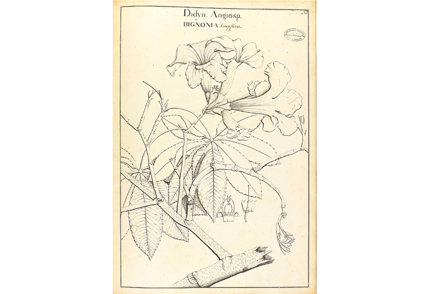Abstract
While reviewing Vellozo’s Bignoniaceae names in Floræ Fluminensis, a nomenclatural novelty came to light. The name Bignonia longiflora Vellozo, being a later homonym of B. longiflora Cavanilles, was deemed illegitimate. Consequently, Vellozo’s name was eventually replaced with Tecoma speciosa Candolle ex Martius. However, when Tabebuia Gomes ex Candolle was considered the correct genus for this, the final combination ‘Tabebuia speciosa’ was not presented as it was blocked by Tabebuia speciosa Standley (1930). Instead, Tabebuia vellosoi Toledo (1952) was proposed in order to assign a name for Bignonia longiflora Vell. illeg., / Tecoma speciosa DC. ex Mart. Posteriorly, Handroanthus gained broad acceptance as the correct genus and the combination Handroanthus vellosoi (Toledo) Mattos was proposed, bypassing the previously validly published, Tecoma speciosa. However, the latter name holds priority over Tabebuia vellosoi Toledo (≡ Handroanthus vellosoi (Toledo) Mattos), resulting in a new combination, Handroanthus speciosus (Candolle ex Martius) M.Nascim., J.F.B.Pastore & Zuntini, as presented here. This nomenclatural novelty is accompanied by a distribution map, illustration, typification of all involved names, and nomenclatural and taxonomic notes.
References
- Bureau, E. & Schumann, C. (1896−1897) Bignoniaceae. In: Martius, C.F.P. von, Eichler, A.W. & Urban, I. (ed.) Flora brasiliensis, vol. 8 (2). F. Fleischer, Munich, pp. 69–121. https://doi.org/10.5962/bhl.title.454
- Candolle, A.P. de (1838) Revue sommaire de la famille des Bignoniacées. Bibliothèque Universelle de Genève 17: 117–136.
- Candolle, A.P. de (1845) Bignoniaceae. In: Candolle, A.P. de (Ed.) Prodromus systematis naturalis regni vegetabilis, vol. 9. Paris, pp. 142−248. https://doi.org/10.5962/bhl.title.286
- Cavanilles, A.J. (1801) Icones et descriptiones plantarum, vol. 6. Typographia Regia, Madrid, pp. 41–97. [https://bibdigital.rjb.csic.es/idurl/1/9684]
- Gentry, A.H. (1975) Identification of Vellozo’s Bignoniaceae. Taxon 24: 337−344. https://doi.org/10.2307/1218342
- Gentry, A.H. (1992) Bignoniaceae—Part II (Tecomeae). Flora Neotropica Monograph 25: 1−370.
- Grose, S.O. & Olmstead, R.G. (2007a) Evolution of a charismatic neotropical clade: molecular phylogeny of Tabebuia sl, Crescentieae, and allied genera (Bignoniaceae). Systematic Botany 32: 650−659. https://doi.org/10.1600/036364407782250553
- Grose, S.O. & Olmstead, R.G. (2007b) Taxonomic revisions in the polyphyletic genus Tabebuia s. I. (Bignoniaceae). Systematic Botany 32: 660−670. https://doi.org/10.1600/036364407782250652
- IPNI (2023 [continuously updated]) The International Plant Names Index. Available from: https://www.ipni.org/n/158959-1 (accessed: 23 July 2023).
- JSTOR Global Plants (2023) Available from: https://plants.jstor.org/ (accessed: 23 July 2023).
- Kuntze, O. (1898) Revisio generum plantarum vol. 3 (2). Arthur Felix, Leipzig, 535 pp. [in German] https://doi.org/10.5962/bhl.title.327
- Lima, H.C.D. (1995) Leguminosas da Flora Fluminensis-JM da C. Vellozo: lista atualizada das espécies arbóreas. Acta Botanica Brasilica 9: 123−146. https://doi.org/10.1590/S0102-33061995000100006
- Lohmann, L.G. (2023) Handroanthus. In: Flora e Funga do Brasil. Jardim Botânico do Rio de Janeiro. Available from: https://floradobrasil.jbrj.gov.br/FB114100 (accessed: 9 June 2023).
- Martius, C.F.P. (1841) Herbarium Florae Brasiliensis. Continuato. Flora 24 (2, Beibl. 1−7): 1−112.
- Mattos, J.R. (1970) Handroanthus, um novo gênero para os ‘‘ipês’’ do Brasil. Loefgrenia 50: 1−4.
- Mattos, J.R. (1991) Comunicações avulsas de Botânica. Loefgrenia 100: 3−4.
- Nicholson, G. (1887) The illustrated dictionary of gardening vol. 7. L. Upcott Gill, London. 112 pp. https://doi.org/10.5962/bhl.title.247
- Pastore, J.F.B., Mota, M., de Menezes, H.F. & Trovó, M. (2021) Vellozo’s Florae Fluminensis: A new assessment of the São Paulo part of his collecting itinerary, its vegetation, and species list. Taxon 70: 1078−1095. https://doi.org/10.1002/tax.12509
- Pastore, J.F.B., Trovó, M., Mota, M., Antar, G.M., Maruyama, A.S.C. & Paula-Souza, J. (2022) Recommendations for typification of Vellozo’s names from Cunha, São Paulo (Brazil): Eriocaulaceae, Polygalaceae, and Violaceae. Brittonia 74: 321−332. https://doi.org/10.1007/s12228-022-09726-8
- POWO (2023) Plants of the World Online. Facilitated by the Royal Botanic Gardens, Kew. Available from: http://www.plantsoftheworldonline.org/ (accessed: 23 July 2023).
- QGIS Development Team. (2021) QGIS Geographic Information System. Open Source Geospatial Foundation Project. Available from: https://qgis.org/en/site/ (accessed: 23 July 2023).
- Reflora (2023) Herbário Virtual. Available from: http://floradobrasil.jbrj.gov.br/reflora/herbarioVirtual/ (accessed: 23 July 2023).
- Richard, L.C.M. (1792) Catalogus Plantarum. Actes de la société d’histoire naturelle de Paris 3: 105−114. https://doi.org/10.5962/bhl.title.86323
- Schumann, K. (1894) Bignoniaceae. In: Engler, H.G.A. & Prantl, K. (Eds.) Die natürlichen Pflanzenfamilien, vol. 4 (3b). W. Engelmann, Leipzig, pp. 189–252.
- Silva, P.A., Silva, L.L., Cherutte, A.G., Gomes, A.C.S., Brito, L. & Rodrigues, B.M. (2021) Aves visitando flores do ipê-amarelo (Handroanthus vellosoi) na área urbanizada ressalta a importância da interação planta-animal na arborização de cidades. Research, Society and Development 10: 1−18. https://doi.org/10.33448/rsd-v10i15.22982
- SpeciesLink (2023) Centro de Referência em Informação Ambiental—CRIA. Available from: https://specieslink.net/search/ (accessed: 23 July 2023).
- Standley, P.C. (1930) Studies of American plants—III. In: Publications of Field Museum of Natural History, vol. 8. Chicago, pp. 1–74.
- Toledo, J.F. (1952) IV—Notulae de aliquot plantis Brasiliensibus novis vel minus cognitis. Arquivos de Botânica do Estado de São Paulo 3: 1−49.
- Turland, N.J., Wiersema, J.H., Barrie, F.R., Greuter, W., Hawksworth, D.L., Herendeen, P.S., Knapp, S., Kusber, W.-H., Li, D.-Z., Marhold, K., May, T.W., McNeill, J., Monro, A.M., Prado, J., Price, M.J. & Smith, G.F. (2018) International Code of Nomenclature for algae, fungi, and plants (Shenzhen Code) adopted by the Nineteenth International Botanical Congress Shenzhen, China, July 2017 [Regnum Vegetabile 159]. Koeltz Botanical Books, Glashütten, 254 pp. https://doi.org/10.12705/Code.2018
- Vellozo, J.M. da C. (1829 [1825]) Floræ Fluminensis. Typographia Nationali, Rio de Janeiro, 352 pp. https://doi.org/10.5962/bhl.title.745


